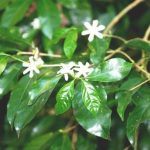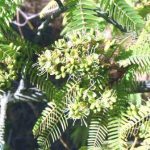TREE LIFE
DECEMBER 1994
The Chairman and members of the Committee wish all our members and their families a really Happy Christmas
MASHONALAND CALENDAR
Sunday 4th December: The Christmas Social/ monthly outing has been brought forward a week for two reasons:
i) the History Society is having a Christmas meeting on the 11th December and
ii) This will be a wonderful opportunity to see Kim and Cecile, who will be in Zimbabwe for just a week prior to going on to Cape Town.
The venue too has been changed, to Chedgelow Farm which is a delightful spot close to town. So bring a special Christmas picnic lunch and enjoy the trees and the company. We will meet at 10.00 a.m.
Tuesday 6th December: Botanic Garden Walk at 4.45 for 5 p.m. We will meet Tom in the public car park of the Gardens, and continue where we left off last month with Rubiaceae.
Saturday 17th December: Mark’s walk will be at the Greystone Park Nature Reserve in Halford Road. Two visits have been made there and it is a rich site with a wide variety of habitats. We meet as usual at 3.00 p.m.
Sunday 1st January 1995: A HAPPY NEW YEAR TO US ALL WITH DECENT RAINS AND MANY HAPPY HOURS BOTANISING IN 1995.
Tuesday 3rd January: Botanic Garden Walk.
MATABELELAND CALENDAR
Sunday 4th December: A leisurely morning stroll through Bulawayo Golf Course with much, so Clem assures me, of interest. I am not quite sure how the golfers will receive our presence. Tea will be provided at Girls’ College afterwards. The usual 8.30 rendezvous at Girls’ College.
Sunday 1st January: Our annual social at the lovely home of Tom and Mary Raub. Details in the next Tree Life.
Monday 2nd January: To Mazwi Nature Reserve.
Friday 3rd to Sunday 5th February: A visit for botanical enthusiasts to Buchwa for Harare and Bulawayo members. Accommodation for twenty people at $60 per person per night, (this will entail sharing as there are 10 two bedded rooms). Dinners will be catered at $30.00 each but we shall take our own light breakfasts and portable lunches. There are no cooking facilities. Please phone Margaret or Ian McCausland on Bulawayo 41946 after 5 p.m. if you are interested. First come first booking, but we stress that this is a trip for the botanically obsessed.
Mrs. Gillian Margaret Masterson
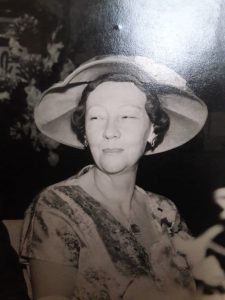 We are grieved to record the death, on 30th October, of Mrs. Gill Masterson. Her passing is a sadness, but the Tree Society remains immeasurably the richer for the stimulating presence, until her 90th birthday, of that grand old lady.
We are grieved to record the death, on 30th October, of Mrs. Gill Masterson. Her passing is a sadness, but the Tree Society remains immeasurably the richer for the stimulating presence, until her 90th birthday, of that grand old lady.
Her love of the country, her first-hand knowledge of its rich variety in terrain and vegetation and her lively interest in its people, gave her a quiet authority, never obtrusive where members of the Society were concerned, but always there for those who learnt the delight of turning to her. A lady of principle, a stickler for etiquette, she frowned on the shoddy and the insincere.
Yet the sometimes-stern countenance would be transformed in an instant to reflect emotions ranging from deep concern in the one extreme to a quiet flash of merriment in the other – the latter accompanied by a chuckle that was in itself a joy to hear. Her sympathetic interest in both the achievements and the vicissitudes of others attracted to her the confidences and the high regard of young and old.
Gill’s husband, Bernard, had a most distinguished career in the old Native Dept. of S. Rhodesia and later Rhodesia’s Ministry of Internal Affairs. He and Gill were married in 1935 and posted immediately thereafter to Shamva. In a long, interesting, challenging career they were stationed also in Gwanda, Bindura, (for ten years), Mt. Darwin, Goromonzi, Buhera, Rusape, Gweru, Mutare and Harare.
Among the places of which Gill also spoke with nostalgia were Shabani, Belingwe, Kwekwe, Gokwe, Kariba, Mutoko, Wedza, and Nyamaropa… The list was almost endless, understandably so when one considers that in one station alone, that of Mutare, Bernard’s responsibilities as Provincial Native Commissioner extended from the Ruenya in the northeast corner of Nyanga to the Sabi – Lundi junction in the far south. It was, Gill used to say, in the area known in past days as the Masembura Reserve, in the Bindura district which they grew to know intimately and to love in the 1930’s and 1940’s, that with the help of an Agricultural Demonstrator, Luke Chabikwa and some of the other men of the area, she and Bernard began to learn the names of the trees around them. But Bernard’s greater interest was in birds, and over the years when he, and often their son, Alex, became absorbed in that study (a field in which Alex has become an authority), Gill concentrated more and more on the vegetation.
At Cape Town University in her youth, Gill’s BA degrees had embraced Botany, Zoology and History, and while her enquiring mind remained receptive in all three spheres of interest, it was her botanical bent that came to claim priority. She had the most retentive memory of each area, of the precise location the very promontory or nook or cranny on which, or in which, she had at any time come across a specimen of some rarity. And in later years it gave her infinite pleasure to have this rarity confirmed, on occasions, at the National Herbarium, where she gained the admiration and respect of Mr. Muller and Mr. Drummond.
While in Manicaland, Gill was able to consult for species identification, that remarkable botanist, Mr. Chase, and he accompanied Bernard and Gill on some of their journeys. Bernard died in 1966, a few months before he was due to retire. A stricken Gill resumed, after a while, visits to their many friends in the districts. She was probably never known to return without some botanical specimen of interest “in the press”.
It was in the mid 1970’s that Gill, having settled in Harare, was persuaded to join the Committee of the Tree Society and to take charge of the Learners’ Group. She was in her element. Her protective hockey pads and walking stick beat many a path over broken ground, with scant regard to snakes and black-jacks, and her successive groups of learners never looked back. Even when, eventually, infirmity seriously limited her travelling, her interest in our outings continued. She would listen eagerly to the events of the day, share the excitement of an unexpected find, wish to know whether a particular plant, recalled to mind from a previous visit, had been spotted. Her enthusiasm never waned.
Gill Masterson – “Lady M” (Lady Msasa) – to some of her friends – is sadly missed. She will be affectionately and gratefully remembered.
-Dick Petheram
BOTANIC GARDEN WALK: 1 NOVEMBER 1994
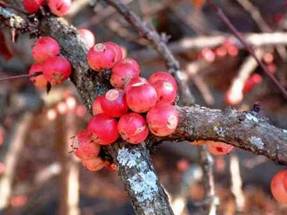
Feretia aeruginescens. Photo: Rob Burrett. Source: Flora of Zimbabwe
In the third session on the Rubiaceae, Tom began by showing us a very attractive white-flowered shrub with reddish-green leaves, Feretia aeruginescens. The fruit are red (here they were rather old and brownish) and short-stalked and grow on the branches. This species occurs on riverine terraces, along lowveld rivers and dry streams. It is quite easily grown and makes an attractive garden subject.
Many of the trees examined were at a rather awkward stage, having just finished flowering and in the process of producing new leaves which were often immature and uncharacteristic.
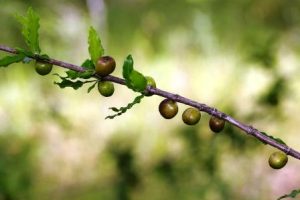
Coffea racemosa. Photo: Bart Wursten. Source: Flora of Zimbabwe
In the lowveld section we saw Coffea racemosa with pink flowers, sadly just going over, and newly appearing pinkish leaves. This is a species of the SE lowveld (we saw it at Bangala Dam last Year). Tom mentioned that flowering in lowveld trees was often a “one day wonder”.
Another species of the SE lowveld is Tricalysia junodii var. junodii. Somewhat strangely, this is very different in appearance to the var. kirkii (formerly known as Tricalysia allenii) of the same species.
Gardenia volkensii (formerly Gardenia spatulifolia) does indeed have spathulate (or spoon-shaped) leaves. Tom remarked on its strange ecology. In the Okavango, it can take flooding, continuing to flower, even under water, and occurring on the edges of pans. The number of corolla lobes was variable, but commonly 3 or 9. This differed from Gardenia resiniflua, which was consistently 5-lobed on the one we examined.
Once again, we thank Tom for sharing his knowledge with us and look forward to examining the genus Coffea next month.
-MARK HYDE
The Presentation to Mr. Tom Muller
It was a lovely evening at Chapungu for Tom’s presentation. In their speeches both Trevor Gordon and Tom reminisced about the early days. Of Tom’s arrival in the country, his unusual clothing (pointed shoes and a blue suit with floral shirt were mentioned) designing and developing the garden, their adventures while collecting plants from all corners of this country as well as from neighbouring countries. And the people they worked with, some whom we know, like Bob Drummond and others sadly just names such as H. Wild and G. Pope. Tom thanked the members of the Tree Society for their gifts (he chose some very up-market electrical household appliances). Thank you all who came and for the delicious eats you brought with you.
VISIT TO INUNGU 6 NOVEMBER, 1994
On a warmish day about 20 Tree Society members made the trip to INUHGU hill inside the Matopos National Park. The more energetic members went right up to the cross on the top of the hill. The others took a more leisurely stroll to various points up the path according to their energy and to what they found of interest to look at. For me the highlight of the day was finding Strychnos usambarensis and Euclea racemosa in plentiful seed. At first glance Strychnos usambarensis could be confused with Strychnos matopensis but the former lacks the climbing tendrils of the latter and is also an upright growing tree and the fruits are almost globose as opposed to the flatter obovate fruits of Strychnos matopensis. Another difference is the leaves of Strychnos usambarensis, which are longer than broad and definitely pointed at the apex. Large numbers of Croton gratissimus were covered in long sprays of scented whitish yellow flowers. Other trees seen in flower were Calodendrum capense (few) Mundulea sericea and Sericanthe andongensis. Ptaeroxylon obliquum were in bud. There were unusually large numbers of Homalium dentatum and Olea europaea.
The tree/shrub species seen were as follows:
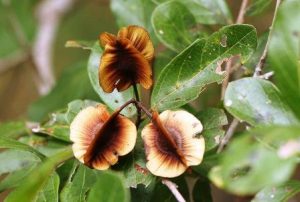
Combretum apiculatum. Photo: Bart Wursten. Source: Flora of Zimbabwe
Acacia rehmanniana, Brachylaena rotundata, Burkea africana, Calodendrum capense, Catha edulis, Combretum apiculatum, Combretum hereroense, Combretum molle. Commiphora marlothii, Commiphora mollis, Cordia grandicalyx, Croton gratissimus, Diospyros lycioides, Euclea divinorum, Euclea racemosa, Euphorbia ingens, Ficus glumosa, Ficus ingens, Ficus natalensis. Grewia monticola, Heteropyxis dehniae, Homalium dentatum, Kirkia acuminata, Lonchocarpus capassa, Mimusops zeyheri, Mundulea sericea, Nuxia congesta, Olea europaea. Pavetta eylesii, Ptaeroxylon obliquum, Pterocarpus rotundifolius, Rhus lancea, Rhus leptodictya, Rhus pyroides, Sclerocarya birrea, Sericanthe andongensis, Steganotaenia araliacea, Strychnos matopensis, Strychnos usambarensis. Tarchonanthus camphoratus, Tarenna zimbabwensis, Terminalia sericea, Vepris reflexa, Ximenia americana, Ximenia caffra, Ziziphus mucronata.
Shrubs
Barleria albostellata, Cissus cornifolia, Maytenus heterophylla subsp. pubescens.
This area would definitely be worth another visit when the more deciduous species have had more rain to wake them up.
-ANTON ELLERT
NYARUPINDA CATCHMENT November 1994
FROST Part 3 Preamble
There are questions at the end of every chapter in Basic Horticulture by V. T. Gardner (Professor of Horticulture at Michigan State College, 1948). For example explain the difference between a frost and a freeze. This set me thinking about the answer and the need to define some of the words used in Parts 1 and 2 in this series on frost.
Preparation of this series has shown me that the more dictionaries and references consulted the more difficult it is to find a suitable definition. You may trample these pearls if they are fake… if these definitions are found wanting, you must say so in Tree Life, then all of us will be wiser.
With reference to Part 1; Conduction is a term used in Physics to describe the transmission of heat, sound, or electricity through matter without motion of the conducting body as a whole, distinguished from convection and radiation.
Radiation is a process for the transport of energy, e.g. heat, from one place to another in the form of electro¬magnetic waves. These waves of radiant energy, as from the sun, can pass through solids, liquids, gases, space and a vacuum. In his book Wayward Winds Jack Tattle tells us that the term radiation, as used in meteorology, refers only to solar (short-wave) and terrestrial (long-wave) radiation. Solar radiation received by the earth is called ‘insolation’.
Latent Heat is a term used in Physics, it is the amount of heat required to change the state of a unit mass of a substance from solid to liquid or from liquid to vapour, without changing the temperature of the substance; the heat is hidden. Experiments show that while ice is being melted into water, or water is being boiled to produce steam, no actual rise in temperature takes place; therefore, heat supplied to alter the state of water is somehow absorbed by the water itself where it remains hidden. When the water is changed to a cold state, vapour to water, water to ice, the process is reversed. The heat withdrawn from the H2O to effect the change has been latent, its release from the H2O does not go unnoticed because it warms the immediate surroundings: see the last paragraph of Frost Part 1.
As regards a Frost and a Freeze, Funk and Wagnall’s Standard Dictionary (Colliers) has been the most helpful reference book.
A Frost ‘Minute crystals of ice formed directly from atmospheric water vapour;’ was this the difference that V. R. Gardner had in mind? His text has been searched for the answer, but without success.
A Freeze ‘To become converted from a fluid to a solid state by loss of heat; become ice.’ The standard freezing point for pure water is 0o Celsius at sea level atmospheric pressure, where the normal height of the mercury in a barometer is about 76 cm. But pressure decreases with altitude and at Harare (1 500 m), for example, the height of the mercury is approx. 64 cm. The question is does this affect freezing point. My thanks to Phill Mugford for searching Encyclopaedia Britannica for the answer, foils again; nevertheless he gathered that a higher temperature of freezing would hardly be measurable. At the other end of the temperature scale, water’s boiling point is directly affected by atmospheric pressure.
The Cellular Basis of Freezing Damage
Freezing damage depends on ice formation within plant tissues. If there are only a few degrees of frost the most common form of damage occurs outside the cells in the intercellular spaces, this is called extra-cellular freezing. The present view (1984) is that this damage is caused primarily by the withdrawal of water from the cells into growing ice crystals, and that frost injury is then a form of desiccation damage, cells shrink, become distorted and compressed. For instance the epidermis of leaves may separate from the underlying palisade tissue. Cells do not rupture because their walls, consisting of cellulose plus other reinforcing substances, have a latticed construction that is porous, tough and somewhat elastic.
Another effect of freezing is thought to be damage to cell membranes, there are two, they are like a double envelope, the inner one holds sap in the vacuole, the outer holds the cytoplasm inside the wall of the cell, both are semi-permeable. Loss of semi-permeability and outward leakage of cell contents is among the first signs of injury. It is for this reason that domestically frozen vegetables lose their ‘crisp’.
Ice crystals form inside the cells when cooling is rapid and severe as happens in black frost. The damage varies from the death of a few leaves to death of the whole plant when freezing is intracellular. Frosted plants must be thawed slowly; grass wigwams can protect plants from rapid thawing.
Chemical disturbance does occur in frozen tissues but at this low temperature the reactions are slow.
“… The sap in exposed vegetation will freeze:
The sap in vegetation will freeze when the temperature of the air has dropped well below 0° Celsius. Frost was widespread on Friday July 1 1994; a sub-zero ground temperature recorded at Gweru was minus 7.6° degrees C.
Black frost damaged wheat, flowers, vegetables, fruit, coffee, plantation trees and indigenous vegetation. When actively growing, most plant tissues contain 70-95% water. Plants generally, cannot control their temperature so they become frozen at temperatures below zero.
In a typical plant cell, sap fills the vacuole in the centre of the cell, sap is water in which sugars and salts are dissolved, it will freeze in accordance with the principle that the more ‘impurities’ in the water, the lower its freezing point. The sap in phloem cells (sieve tubes) is the least freezable as compared with that in xylem vessels and in unspecialised, parenchyma, cells. Phloem sap is viscous and sugars comprise 90% of the solids, many other compounds are present. Aphids have been put to work by plant physiologists to extract phloem, sap for analysis.
Xylem sap is a clear fluid with a viscosity of about 1. Its total dry matter, mainly minerals, rarely exceeds 1%. Street and Opik in their Physiology of Flowering Plants say that sugar maple and birch xylem may contain up to 8% sugar for a limited period in early spring.
FROST Part 4 will be short; “Trees and Frost” will end this series.
There is a lot of civet news piling up.
-Benedicta Graves
THORA’S HERBAL REMEDIES
EYE REMEDIES
1. NON HERBAL SALINE SOLUTION
Though I have not had any experience with horses and their watering eyes, I would first try a weak saline solution which is always soothing and healing.
Mix ¼ teaspoon salt to a cupful boiling water. Allow to cool and bathe the eyes regularly, using each time a clean piece of cotton wool soaked in the Solution.
As a matter of interest this same saline solution has been used in our family for generations for settling an uneasy stomach. If feeling nauseous, or having eaten food which disagrees, this remedy drunk while still hot, quickly takes away that awful sick feeling. I can recommend it to migraine sufferers too.
We used to have an African family next door whose colicky baby used to scream and cry morning, noon and night, till I suggested a few grains of salt added to the water in her feeding bottle. Peace, perfect peace, reigned once more.
It was therefore of great interest no note that a saline and sugar solution is now the acknowledged remedy for dysentery, keeping infants and adults from dehydrating. On the Sealink, voyaging from Southampton to Jersey in 1983, a young mother, with two toddlers was being awfully sick. The children, upset by mother’s condition, were crying as father stood by helplessly. I again suggested the saline solution for both mother and children with almost instant success.
I always take the weak solution before any air or sea travel. Ken’s lucky, he never suffers any trauma when travelling.
HERBAL EYE TREATMENTS
There are numerous remedies that are well worth trying. An excellent European lotion is made from 10 grammes Plantain leaves
5 grams cornflower flowers
5 grams melilot flowers (this is very like lucerne with yellow flowers instead of mauve)
Pour over 150 grams boiling water. Leave to infuse for 15 minutes. Strain through a fine cloth. This lotion can be used as an eye wash or on compresses.
Nasturtium leaves and flowers or calendula flower petals also make good eye lotions – ¼ cup of herb to cup of boiling water.
Blackjack Eyewash
This is a folk remedy for soothing chronic eye irritations and infections – also said to prevent cataracts?
1 tablespoon chopped blackjack leaves
5 cloves
Pour 1 cup boiling water over these. Steep and strain. Use as an eye bath morning and evening. Keep excess in the refrigerator.
Wild Olive Olea europaea subsp. africana
An excellent eye oath is made from the fresh leaves.
10 leaves to 1 cup boiling water.
Leave to draw 10 minutes.
Strain and use twice daily.
-THORA HARTLEY
TREES AND MYTHS
Rob Burrett’s article in TREE LIFE No. 177 raises a number of interesting questions, but I don’t think he is going to get any entirely satisfactory answers on the origin (s) of Tamarindus indica. I have consulted a number of reference works, and the best I can come up with is that the species is probably indigenous to Africa. It is certainly, much more widespread in this continent than the safari guides seem to be suggesting to their clientele; the Zambezi–Luangwa distribution is simply the southernmost, limit of the species’ natural range in Africa.
D. OLIVER (1871) FLORA OF TROPICAL AFRICA. L. Reeve & Company, London.
In this multivolume work Tamarindus indica is listed as present in Senegambia, Abyssinia, Angola, south-central Africa, and Mozambique.
R. S. TROUP (1921) THE SILVICULTURE OF INDIAN TREES. Clarendon Press, Oxford.
Tamarindus indica L. Said to be indigenous in Abyssinia and central Africa. Largely planted in India along roads and avenues… In Burma it is one of the commonest of village trees in the dry zone.”
Troup was one of the great professional foresters in India in its colonial days, and was the author of a number of text books. His 1921 publication quoted above is still an important reference work on Indian trees. It may be significant that Troup did not suggest an Indian origin for Tamarindus indica, and it would seem that the species was originally described and named from specimens growing in India, hence the specific name indica. This would not be the only case of a species being first collected and described from an exotic environment and one of the most famous is Eucalyptus camaldulensis. This tree is the most widespread eucalypt on the Australian mainland, but it was first described and named from a cultivated specimen growing in a nursery in Camalduli, a district in Tuscany, Italy.
L H BAILEY (1950) THE STANDARD CYCLOPEDIA OF HORTICULTURE. MacMillan, New York
“Tamarindus (from the Arabic tamar-Hindi, meaning Indian date). A tropical genus containing but one species, the well-known tamarind. It is considered to be indigenous to tropical Africa (the Upper Nile region) and possibly to Southern Asia as well. It has long been cultivated throughout the tropics of both hemispheres, being grown as an ornamental and for its acid fruits, which have many uses. The tamarind became known in Europe during the Middle Ages, doubtless through the Arabians. Until correctly described by Garcia d’Orta (1563) it was supposed by Europeans to be produced by an Indian palm.”
Evidently myths about Tamarindus indica are nothing new!
J.C. WILLIS (1951) A DICTIONARY OF FLOWERING PLANTS AND FERNS. Cambridge University Press.
“Tamarindus Tourn. ex L. Leguminosae (II. 3) 1 trop. Afr.(?),T. Indica L., the tamarind, largely cultivated in the trop. for its ed. fruit…”
EGGELING & DALE (1951) INDIGENOUS TREES OF THE UGANDA PROTECTORATE.
“Tamarindus indica A common tree in the drier savannas, frequently growing on or beside anthills.”
DALE & GREENWAY (1962) KENYA TREES AND SHRUBS. Buchanan’s Kenya Estates.
“Tamarindus indica L. Coast, Southern, Northern and Nyanza Provinces; sea-level to 4 500 ft. A common tree in drier savannas…”
- J. STREETS (1962) EXOTIC FOREST TREES OF THE BRITISH COMMONWEALTH Clarendon Press, Oxford.
“It is believed to be a native of tropical Africa, though most commonly grown in India…” - E. WICKENS (1981) THE BAOBAB – AFRICA’S UPSIDE-DOWN TREE. Kew Bulletin Bol. 37(2)
“It has been suggested by a number of authors that the close association of the baobab (and tamarind) with villages indicate that the tree (the baobab) must have been introduced by man. This may certainly be true for some sites but I am equally convinced that there are also many villages that have been sited so as to take advantage of the existing shade of an indigenous baobab.” - J. MABBERLEY (1993) THE PLANT-BOOK. A portable dictionary of the higher plants. Cambridge University Press,
“Tamarindus indica L. Leguminosae (I 4) 1 cultigen (?orig. trop. Afr.):
(Tararind, Indian date) – cult. orn. shade tree..”
The weight of evidence, then, is that Tamarindus indica is a native of Africa. So, how does it come to be so common in India and Burma, and possibly Sri Lanka too? As I see it, there are two real possibilities:
1. It was introduced into Southeast Asia by Arab traders. This need not be mythical at all for there is plenty of evidence to connect the Arabs with the spread of the African baobab (Adansonia digitata) into Southeast Asia, so why not Tamarindus indica as well? To quote again from Wickens (1981) “The baobab is fairly widely distributed in India and its distribution coincides remarkably well with the areas under Moslem control and must therefore have been introduced by man early in the thirteenth century at the start of the African slave trade. It cannot be identified in any of the ancient Sanskrit writings and it seems to have no Sanskrit name.”
The test of Sanskrit writings and Sanskrit name seems to be a good one. If the tamarind fails on this score the inference is that it was an Arab introduction into Southeast Asia. But if it can be identified in the ancient writings we would have to conclude that it is probably indigenous in Southeast Asia as well as in Africa. And that brings me to the second possibility.
2. The Gondwanaland connection. It could be that Tamarindus indica is a very old and stable species, and was present in both of what eventually became Africa and India before the break-up of the ancient super-continent. Rob Burrett noted that Acacia nilotica and Albizia amara are present in both Africa and India, but even more remarkable, to my mind, i.e. the presence of Gyrocarpus americanus, Ximenia americana, and Dodonaea viscosa in both Africa and Australia. - I prefer the idea of a Gondwanaland connection to account for the present-day distribution of Tamarindus indica, rather than the idea of evolutionary convergence.
There is good evidence in Eucalyptus of evolutionary convergence to produce common morphological characteristics in genetically isolated subgenera, e.g. the operculum in all species, decorticating bark in some species of each subgenus, the mallee form in some species of each, and lignotubers in some species of each. But I cannot come to terms with the idea of separate progenitors converging into a single species. Someone more knowledgeable than I should comment here.
Lines of trees
I join Rob Burrett in his disbelief of the existence of the so-called lines of trees – baobabs or palms. Anyone claiming their existence would need to produce proof, preferably in the form of aerial photographs, to show that there really are lines.
In connection with the baobab, however, a further quote from Wickens (1981) might be of interest:
“Hollow trees filled with water in the Northern Frontier Province of Kenya were used by slave and ivory raiders from Ethiopia, enabling them to cross otherwise waterless country.
“Early records of European travellers in South Africa noted the use by the Bantu tribes of water stored in natural hollows. A chain of trees across the Kalahari to South-West Africa was used for water storage, with a long-established tradition of death to a traveller who left the bung out of a tree and wasted water.”
My comment here is that chains of trees don’t necessarily mean lines; the chains might wander all over the place. I would have felt happier if Mr. Wickens had provided a solid reference for the observation, but I am also aware that some of the “early records of European travellers in South Africa” repeated mythical stories that have never yet been verified.
-LYN MULLIN
BAOBABS IN MY SOUP (or a first look at Namibia)
Many members of the Tree Society will have heard of the famous baobab at Katima Mulilo on the Zambezi River that was fitted out with a flush toilet at the direction of the District Administrator, a Major Trollip, to relieve the boredom of inactivity during World War II. I had the privilege of seeing this tree recently on a trip to Namibia. It is something of a local monument in Katima Mulilo and there was no trouble in getting directions to it. It is a very ordinary size for a baobab, 3-4 metres in diameter, but I had no tape to measure it with. It stands on the corner of a corner plot and 18 accessible to all. Not to use, of course; just to look at and marvel at the foibles of human nature. The cistern has been removed, and the pan has been filled up with cement. And the door into the loo has been removed, only the door frame remaining, so you are free to go in and sit down If you wish – and read a newspaper, or simply meditate. And in your meditations, you might just notice that the bark of the tree has healed over the hollow that was carved out for the loo some 50 years ago.
From the ridiculous to the sublime, and a thousand kilometres west of Katima Mulilo at a place called Ombalantu, in Ovamboland, there is a huge baobab, around 9 metres in diameter and naturally hollow, that has been turned into a chapel. This tree stands alongside what was a small South African army base, now part of a prison and police complex, and you need the permission of the police to visit it (but this is easily obtained). Inside the chapel is a lectern and seating for 6-8 people on rough benches. I also saw a notice above the lectern, written in German, a very widely used language in Namibia. The doorway into the chapel had obviously been a neatly trimmed modification of the original entrance into the hollow tree, but the bottom of the doorway is about a metre above the surrounding ground. You gain access to the entrance via some natural and man-fashioned steps on the tree itself. The human handiwork on these steps is already covered over with live bark.
-LYN MULLIN
ANDY MACNAUGHTAN CHAIRMAN


